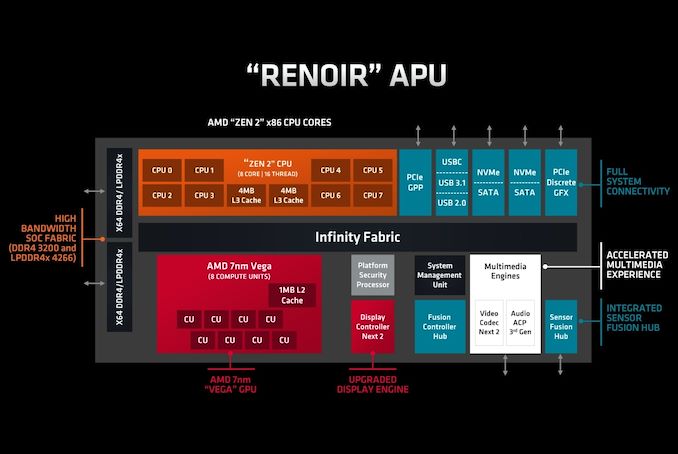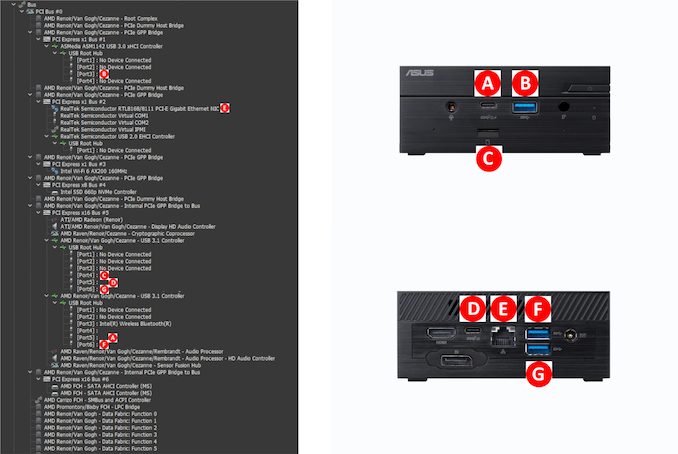ASUS PN50 mini-PC Review: A Zen 2 Business NUC
by Ganesh T S on October 1, 2021 10:00 AM EST- Posted in
- Systems
- AMD
- Asus
- NUC
- UCFF
- Mini-PC
- Zen 2
- Ryzen Embedded
- Renoir
- Ryzen 4000
- Ryzen 7 4800U
Setup Notes and Platform Analysis
Assembling the ASUS PN50 is a trivial task with the disassembling instructions outlined in the previous section. In any case, ASUS sells pre-configured systems suitable for immediate deployment to B2B customers.
The ASUS PN50 sports a regular AMI BIOS offering multiple configuration knobs meant for system administrators in business settings - including configuration of DASH support on the Realtek NIC. The video below presents the entire gamut of available options.
The AIDA64 system report for the sampled hardware configuration provided the following information:
- North Bridge: AMD K17.6 IMC
- PCIe 3.0 x1 port #3 In Use @ x1 (ASMedia ASM1142 USB 3.0 xHCI Controller)
- PCIe 3.0 x1 port #5 In Use @ x1 (Realtek RTL8111xP RealManage Virtual COM1, Realtek RTL8168/8111 PCI-E Gigabit Ethernet Adapter)
- PCIe 3.0 x1 port #6 In Use @ x1 (Intel Wi-Fi 6 AX200 160MHz Wireless Network Adapter)
- PCIe 3.0 x8 port #0 In Use @ x4 (Intel SSD 660p NVMe Controller)
The above breakdown needs to be taken in the context of the fact that the Renoir APUs are monolithic dies. They are true SoCs with all I/Os being sourced from the APU without a platform controller hub (PCH) in the picture.
The distribution of the HSIO lanes for the various ports in the chassis is brought out in the diagram below.
The distribution of various USB ports in terms of bandwidth sharing is much more balanced compared to the ASRock Industrial 4X4 BOX-4800U. This is in part due to the use of the ASMedia ASM1142 discrete USB 3.2 Gen 2 controller in the PC (the equivalent PCIe lane is used for a 2.5Gbps LAN port in the 4X4 BOX-4800U). There is also a microSDXC UHS-I slot in the front panel that is enabled by a Realtek USB 2.0 card reader attached to one of the in-built USB 3.2 Gen 2 controller in the APU.
Moving on to the performance evaluation report, we first take a look at various UL benchmarks, followed by BAPCo's SYSmark 25. Following this, the performance of the system for various real-world workloads including practical applications of cryptographic extensions, etc. is presented.












32 Comments
View All Comments
deil - Monday, October 4, 2021 - link
I have R5700 version of this, and I can tell you that if you add thermal pad the chassis which is full aluminum, it doesn't throttle on 25W. This thing has more cooling than laptops with the same CPU.Mine is TV mounted, and then it's not running a fan at a level I can hear.
Toadster - Friday, October 1, 2021 - link
isn't NUC an Intel name?Samus - Friday, October 1, 2021 - link
Indeed, but it appears the NUC platform is slowly becoming an industry design blueprint instead of a product line. Quite frankly I'm glad this segment is crossing the business-application barrier because there are some substantial benefits to these over, say, an All In One.nandnandnand - Saturday, October 2, 2021 - link
Their fault for calling it "The Next Unit of Computing".evilspoons - Saturday, October 2, 2021 - link
It is, yeah. ASUS calls it a "4x4" as in 4 inch by 4 inch system, which is the generic term. Anandtech calling this a NUC is like referring to Scotties facial tissues as "Kleenexes".Threska - Friday, October 1, 2021 - link
Hmmm. if I use a viewfinder I can hold this article up to my eyes for a stereo effect. :-Dabufrejoval - Friday, October 1, 2021 - link
Ordered a 4800U based PN50 in Summer 2020, listed by the e-tailer as "due next week".It was to become a small low-power but "sprinty" hyperconverged server with a full complement of 64GB of RAM to complement the 8 cores and "max SSD", potentially in a cluster of three if it turned out any good.
Among the most important criteria was very low idle power and “unnoticeable” sound emissions under all loads.
Saw the delivery date slip further and further until it became "unknown".
Cancelled the order and got all three last generations of Intel NUCs within a couple of months (NUC8i7BEH, NUC10i7FNH and NUC11PAHi7), less by design than by market opportunity: they were the only kind available at each point in time and I seem to have been rather lucky with the prices, too (today they all have far higher listings and no availability).
I also got a Lenovo Ultrabook with the Ryzen 5800U as a point of reference, which unfortunately can't be strong-armed into server duty while off-duty as a laptop, for lack of RAM expansion, even if it was hardly more expensive than a similarly equipped PN51 would be, …if it were available: it's quite simply a crazy market!
They all confirm your benchmark findings, but it's rather unfortunate that you don't include power consumption figures for the benchmarks as well, because they are very informative in terms of chip technology and other side effects (noise and energy).
The best thing about the Intel NUCs is their configurability in terms of P1, P2, TAU and fan parameters: You can really tune these machines to your ratio of noise tolerance and performance, effectively making them fit anywhere in the 8-35TDP (sustained) range and matching turbos.
Throughout my own benchmarking I found that the IPC improvements of Tiger Lake vs. the 14nm Comet/Cannon Lakes had the Gen11 quad-core achieve the same multi-threaded performance as the Gen10 hexa-core, on turbo or even after fitting to the 15 Watt envelope on long running workloads.
At the same time Tiger Lake and the Ryzen 3 were also very much the same performance core-by-core when running at the same clock speeds. It’s just much easier to have the Tiger Lake NUC clock higher than a Ryzen U (or any Ryzen for that matter), which has it gain the single threaded crown, ...unless you regulate the power to cut noise.
Because when you force Intel’s CPUs and Ryzen 3 to the same Wattage (=source of noise), Tiger Lake’s single threaded lead is gone, while the older 14nm chips start to really show their age.
Since I wanted to have them run “unnoticeable” under sporadic and sustained loads, I played with the P1, P2, TAU and fan curves to give a bit of turbo leeway for sporadic or interactive loads, while I made sure that they’d clock down before having to rev up the fans too high.
That can be another important differentiator when you want to deploy these for long-term office (or light server) use: These small fans love to eat dust and clog the vent openings when they spin.
You can get a lot more CPU performance out of the 7nm Ryzen 3 for the same heat than from any current Intel.
What I really wanted was all of these in a Mini-ITX form factor with large slow Noctua fans, but that seems a niche even worse served than the NUCs with these low Wattage but speedy SoCs.
And while it’s nice to know that these nice passive cooling replacement chassis exist for Intel NUCs, a somewhat intermediate option (big slow fan, much lower price) is still missing.
Yes, the Xe iGPU beats the Vega8 significantly, even when both share identical DRAM bandwidth (~50GB/s on my systems) and actual power.
But all of these are just terrible at gaming, while they are all quite good for 2D at 4k Linux or Windows.
abufrejoval - Friday, October 1, 2021 - link
I can't imagine that Ryzen 2 APUs are still being produced: They'd compete for the very same foundry capacities as Ryzen 3 APUs.So now that PN50's are finally coming, that means these are what's left over after nobody buys them in notebooks any more.
This means all theoretical long-term and mass deployment benefits of this form-factor, doesn't apply to this product any more.
Caveat emptor!
meacupla - Friday, October 1, 2021 - link
It takes money and time to retool foundries and half of the 5000U series still uses 4000U parts which are just renamed in bios.abufrejoval - Saturday, October 2, 2021 - link
Actually there was an article here by Ian which pointed out, that in fact the Lucienne chips were not just renamed Renoirs even if they share the same Zen2 cores and a very similar iGPU: There is supposed to be significant updates in power management, which may be somewhat more beneficial for battery operated devices.https://www.anandtech.com/show/16451/amds-ryzen-50...